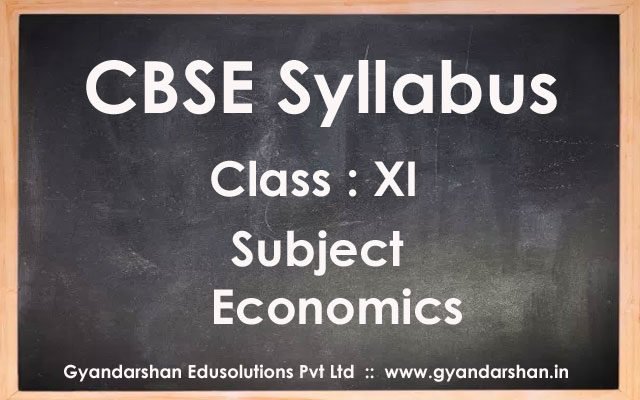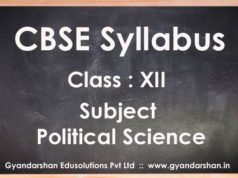
Economics Class XI Syllabus
Exam Structure
| Units | Title | Marks |
| Part A | Statistics for Economics | |
| 1. | Introduction | 13 |
| 2. | Collection, Organisation and Presentation of Data | |
| 3. | Statistical Tools and Interpretation | 27 |
| Part B | Part B: Indian Economic Development | |
| 4. | Development Experience (1947-90) and | 13 |
| Economic Reforms since 1991 | 12 | |
| 5. | Current Challenges facing Indian Economy | 15 |
| 6. | Development Experience of India – A Comparison with Neighbours (OTBA) | 10 |
| Part C | Project Work | 10 |
| Total | 100 |
Part A: Statistics for Economics
In this course, you are expected to acquire skills in collection, organisation and presentation of quantitative and qualitative information pertaining to various simple economic aspects systematically. It also intends to provide some basic statistical tools to analyse, and interpret any economic information and draw appropriate inferences. In this process, you are expected to understand the behaviour of various economic data.
Unit 1: Introduction
What is Economics?
Meaning, scope and importance of statistics in Economics
Unit 2: Collection, Organisation and Presentation of Data
Collection of data – sources of data – primary and secondary; how basic data is collected; methods of collecting data; some important sources of secondary data: Census of India and National Sample Survey Organisation.
Organisation of Data: Meaning and types of variables; Frequency Distribution.
Presentation of Data: Tabular Presentation and Diagrammatic Presentation of Data: (i) Geometric forms (bar diagrams and pie diagrams), (ii) Frequency diagrams (histogram, polygon and ogive) and (iii) Arithmetic line graphs (time series graph).
Unit 3: Statistical Tools and Interpretation
Measures of Central Tendency – mean (simple and weighted), median and mode
Measures of Dispersion – absolute dispersion (range, quartile deviation, mean deviation and standard deviation); relative dispersion (co-efficient of quartile-deviation, co-efficient of mean deviation, co-efficient of variation); Lorenz Curve: Meaning and its application.
Correlation – meaning, scatter diagram; Measures of correlation – Karl Pearson’s method (two variables ungrouped data) Spearman’s rank correlation.
Introduction to Index Numbers – meaning, types – wholesale price index, consumer price index and index of industrial production, uses of index numbers; Inflation and index numbers.
Part B: Indian Economic Development
Unit 4: Development Experience (1947-90) and Economic Reforms since 1991
A brief introduction of the state of Indian economy on the eve of independence. Common goals of Five Year Plans.
Main features, problems and policies of agriculture (institutional aspects and new agricultural strategy, etc.), industry (industrial licensing, etc.) and foreign trade.
Economic Reforms since 1991:
Need and main features – liberalisation, globalisation and privatisation; An appraisal of LPG policies
Unit 5: Current challenges facing Indian Economy
Poverty – absolute and relative; Main programmes for poverty alleviation: A critical assessment;
Rural development: Key issues – credit and marketing – role of cooperatives; agricultural diversification; alternative farming – organic farming
Human Capital Formation: How people become resource; Role of human capital in economic development; Growth of Education Sector in India
Employment: Formal and informal, growth and other issues: Problems and policies.
Inflation: Problems and Policies
Infrastructure: Meaning and Types: Case Studies: Energy and Health: Problems and Policies- A critical assessment;
Sustainable Economic Development: Meaning, Effects of Economic Development on Resources and Environment, including global warming.
Unit 6: Development Experience of India
A comparison with neighbours
India and Pakistan
India and China
Issues: growth, population, sectoral development and other developmental indicators.














